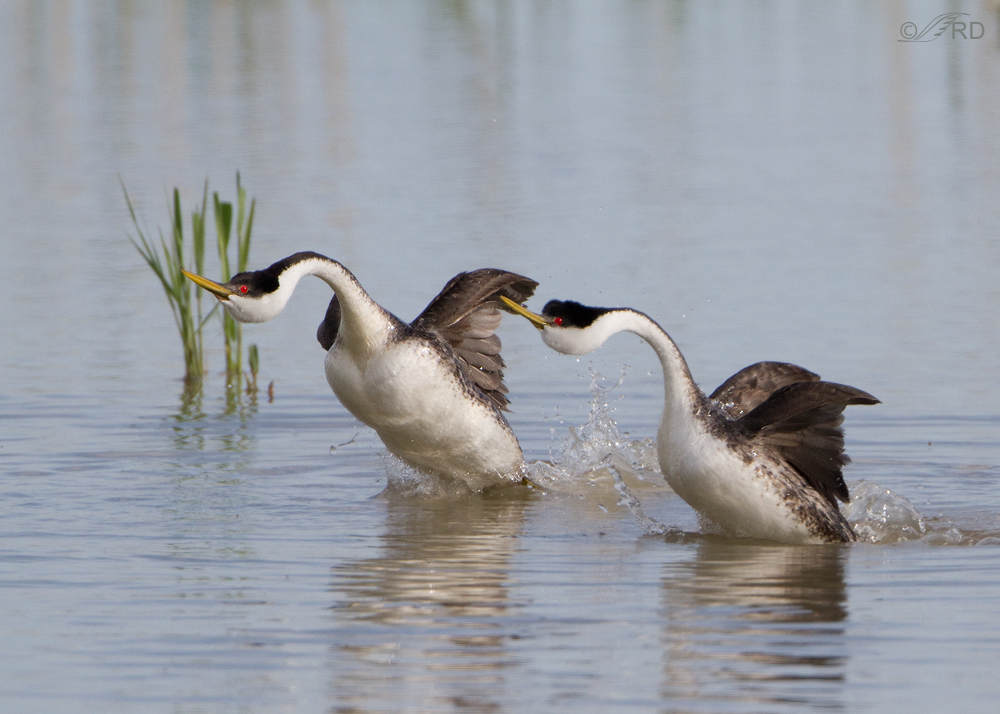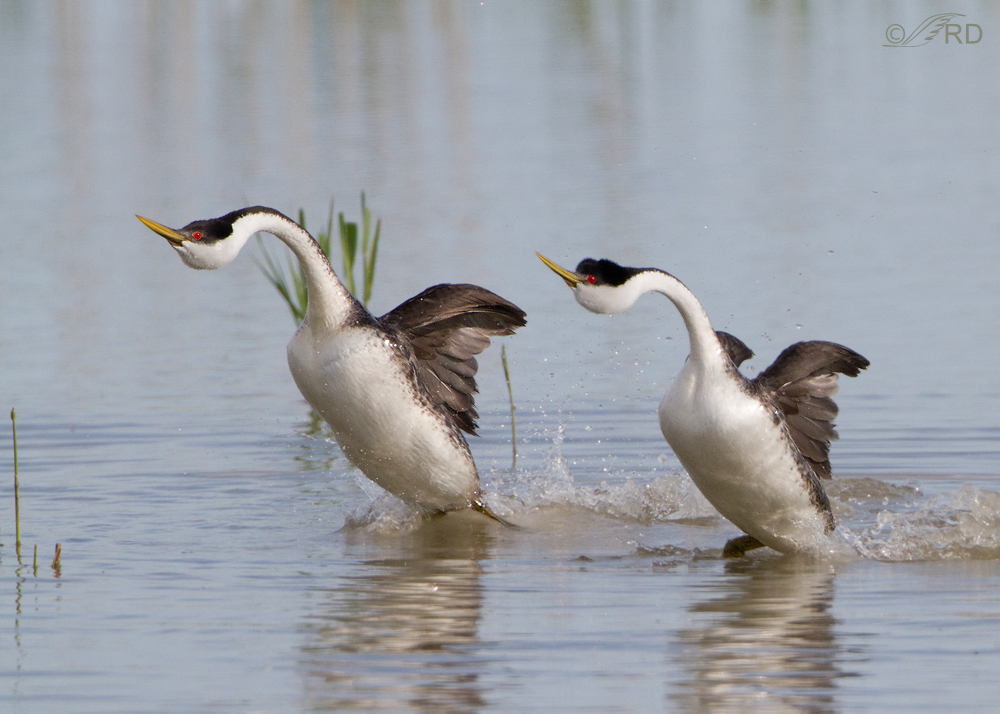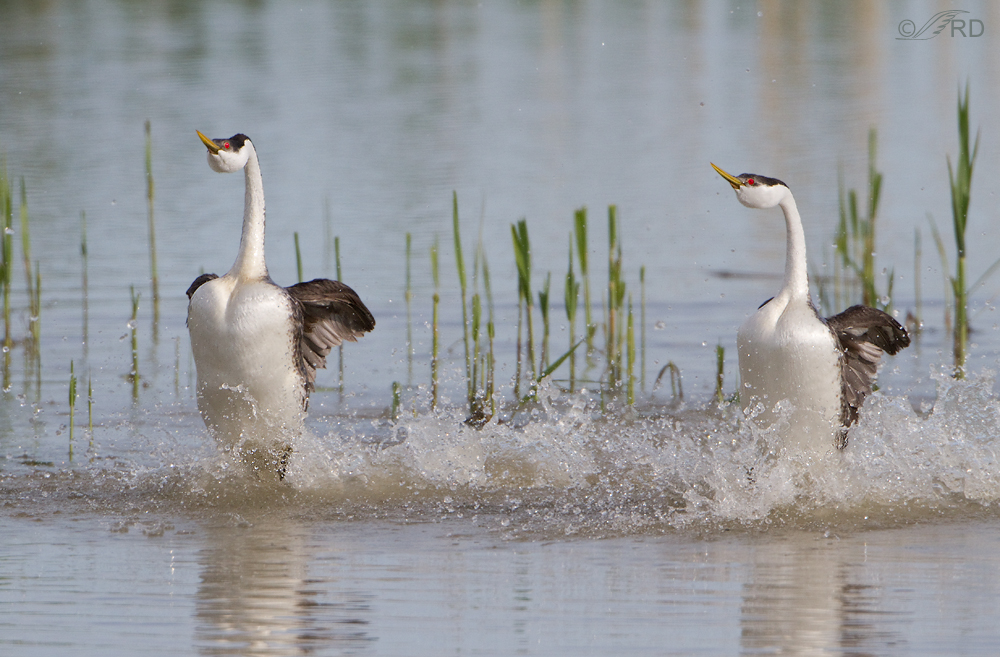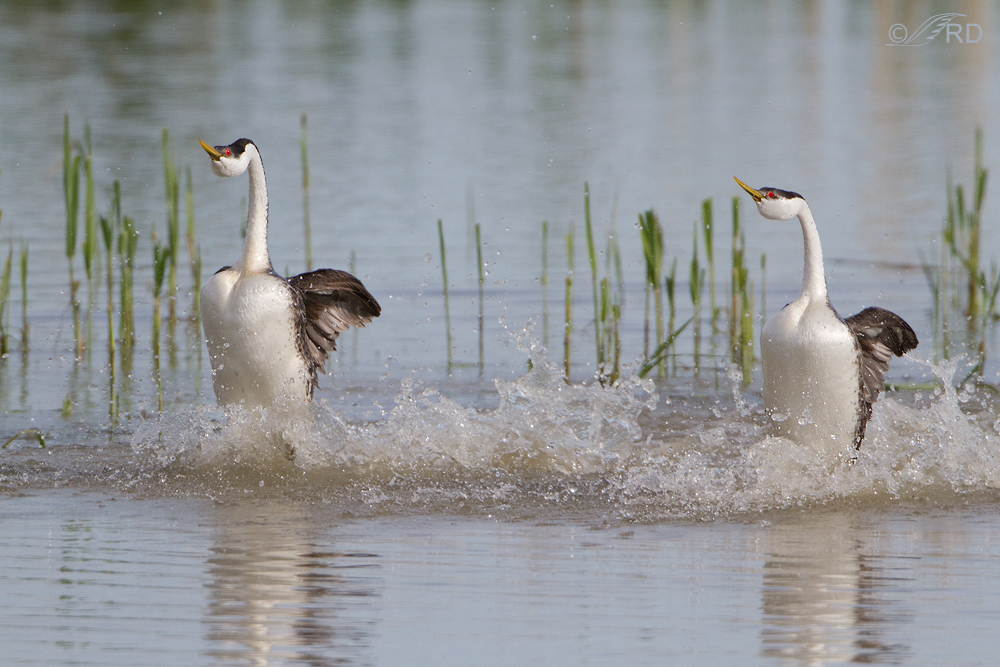Occasionally I recycle an older post that I’m particularly fond of because very few current readers have ever seen it. This one was published June 4, 2012. In this version I’ve rewritten some of the text and changed the formatting.
Quality photos of rushing Western Grebes (or closely related Clark’s Grebes) are very hard to get for a variety of reasons and they’re highly desirable because the behavior is so spectacular and unique. With grebe breeding season coming up quickly I thought this would be a good time to rerun this post – perhaps it will inspire other bird photographers to work at getting their own photos of rushing grebes.
The ritualized displays and courtship ceremonies of Western Grebes are among the most complex known in the bird world. One of them is called the “rushing ceremony” which includes 5 distinct phases – only one of which is actually referred to as “rushing”. Yesterday I finally was able to photograph this most dramatic part of the display and believe me it’s been a long time coming.
I was photographing a pair of these grebes with chicks and though I was aware of another small group of grebes a little further away I was concentrating so intently on those chicks that at first I didn’t notice that the behavior of two of the birds in that group had suddenly changed. When their display began all I had time to do was quickly aim my lens at these birds and fire away. I very nearly missed the performance entirely and I was lucky to be able to lock focus on them because the behavior had already begun.
1/2500, f/7.1, ISO 500, Canon 7D, Canon EF 500mm f/4L IS II USM + 1.4 tc, not baited, set up or called in
When rushing the two birds (usually a mated pair but two males may also do it to attract females) lunge forward and rise completely out of the water.
1/2500, f/7.1, ISO 500, Canon 7D, Canon EF 500mm f/4L IS II USM + 1.4 tc, not baited, set up or called in
As their legs and feet start to churn the water at incredible speeds their bodies begin to raise up…
1/2500, f/7.1, ISO 500, Canon 7D, Canon EF 500mm f/4L IS II USM + 1.4 tc, not baited, set up or called in
until the birds are almost completely vertical to the water and their feet are slapping the surface so fast (16-20 steps per second) that the slapping and splashing noise is loud enough to be heard a great distance away. The wings are lifted but never extended.
The female is on the right – note her smaller size. The bill of the female is also shorter and thinner than that of the male and it has a slightly upturned appearance.
1/2500, f/7.1, ISO 500, Canon 7D, Canon EF 500mm f/4L IS II USM + 1.4 tc, not baited, set up or called in
Both birds run across the surface of the water in a choreographed manner for up to 65 feet before ending the display by diving head first into the water. Neither bird makes any vocalization during the process.
I fired a burst of this behavior and got 17 shots of it but in many of them at least one of the birds was soft. And of course my buffer had filled by the time the display was over so I missed them diving into the water at the end of the performance.
But I have about a half-dozen more quality images of the behavior than I had before so I’m still delighted.
Ron






I don’t know why but seeing these makes me hear classiclal music and the sights of “The Dance of the Sugar Plum Fairy”! 🙂
Hi Ron. Didn’t respond this AM because we have a Eared Grebe in full breeding plumage at one of our ponds on the golf coarse and I don’t suspect he will be around too long, especially considering there are no females around for him to court. I think we are a little south of Eared Grebe’s breeding range and I suspect he will be moving north shortly. Anyway, getting to watch, and attempt to photograph, this behavior on either the Western’s or Clark’s is definitely on my bucket list. I just hope I can make the opportunity happen sometime in the relatively near future. Just need to get to your area, or at least north of where I am at the right time of the year sometime soon to make the opportunity happen.
Thanks for posting and (jokingly) nice to see they were not defecating. Sorry, just had to do it to you.
Oh WOW (insert string of ridiculously redundant superlatives here!)! Birds are such intricately fascinating and outrageously beautiful creatures–the whole lot of them. While videos are wonderful, I really love still photography because you’ve captured a moment in time where you can study all the little details down to the tiniest feather. And you do still photography so darn well.
Thank you for yet another spectacular series of photos and for reposting this series. Just fascinating! (Sorry to be tardy, but there were distractions (SQUIRREL! moments) all day today.
Thank you, Laura. Squirrel moments sound like a good way to spend one’s time, at least for your red-tail…
Oh yes, Mariah LOVES SQUIRREL! moments…LOL! For me, it’s about 17 distractions on the way to doing anything and almost never getting the first objective accomplished–the task I headed to the other side of the house to do. Now if we’re talking REAL squirrels, I’m in!
These are sensational shots Ron!
Charlotte
Glad you like them, Charlotte.
Fantastic Photos!! Bravo!
Thank you, Joanne.
Repeats are like catching up with an old friend. Always welcome.
This would be an incredible sight to see (and hear). I suspect the energy used is HUGE too. The energy just to rise out of the water like that, never mind running…
It makes me tired just to watch them do it, EC!
Ron, great shots. I love the extended necks and heads on these birds as they go through this action. Do you generally shoot in manual mode or one of the priority modes. Also, are most of your shots hand held, which would be a pretty good trick considering the length and weight of the 500 mm and the tc. You didn’t mention a tripod in your discussion on equipment, unless I missed it somewhere. I did read in your post you use a noodle to rest the camera on from within the car. I sometimes use a bean bag on the roof of the car for the same purpose.
Reid, I’m nearly always shooting from my pickup and I’m always using aperture priority.
The bird on the left reminds me of Dolly Parton for some reason….even though supposedly the male….
I can’t imagine why…..
This! Is! Soooooo! Cool! Thank you for reposting this one. I can almost hear their feet slapping the water.
When I see something like this, I’m reminded of that Far Side cartoon, “Animals and their mating songs.” I wonder what the grebes would say if they witnessed some of our courtship rituals. 🙂
Ha, some of the human courtship rituals us high school teachers have seen are truly bizarre. Grebes would know without doubt that we’re bonkers in that regard…
Oh my gosh, don’t get me started. Oy vey! The 2nd floor lounge of our science building overlooks one of the fields where the kids eat lunch — sometimes I just wanted to turn a hose on ’em!
You say that again!!!
I don’t know how long I’ve been following your blogs, but these look familiar…especially the fact that they’re wearing their heads upside down…(which may explain the lack of vocalization)….This must be quite amazing to witness…the noise and commotion must be incredibly intense while it lasts!!! Just for the record, I enjoy “repeats” just as much as new images…
“but these look familiar”
Patty, that might be because in 2014 I posted a different single image of these rushing grebes. Thanks for the kind words about my occasional “repeats”.
Thanks for reposting, great images can almost hear them. Have a dumb geeky question, what do you mean by “lock focus”?
Thanks,
Jo
Jo, that means that sharp focus on the subject was acquired and maintained. Not easy to do with already moving subjects, especially with this kind of background.
Wonderful display ! (from both the Grebes and you )–I, like many people have seen film/video recordings of this behavior, but in those, it’s difficult to see the subtler aspects of the display–
the crooked neck, the puffy breast, the oddly folded wings and so on– I appreciate being able to see beyond the “outboard motors “!
Kris, the first time I “saw” this behavior it was in a Disney documentary of some kind many, many years ago. It was set to classical music and the combination was mesmerizing. I’ve never forgotten it!
These are amazing! I saw this behavior once on my birthday in the Klamath Basin. What a birthday present! There’s a graceful ballet they do just before. I don’t suppose a still photo of that would not be very interesting, but the movements are lovely to watch.
Yes, the entire behavior is quite complex and includes several phases – the actual rushing is only one of them. Thank you, Barbara.
Fantastic shots Ron!! Never have seen these images of yours before so I’m thankful you decided to repost!
Wonderful you were witness to this behavior!
Thanks, Dick. They’re actually among my favorite images of all time, at least in part because they were so difficult for me to get.
WOW! Bravo to you (and the birds) for the display & share of this great moment!
Thank you, Elmer.
Wonderful! 🙂 Glad you were able to capture the “rush”. Incredible amount of energy has to go into that display!
It does, Judy. I suspect it uses more energy than flight (which they seldom do anyway…).
Ron: Thanks for sharing these great shots. This is a bird behavior I have not personally witnessed. That and my deep understanding of just how much skill is required to get shots like yours makes me really love these shots. Thank you.
Skill and luck, Richard. In all the time I’ve spent around Western Grebes I could count the number of times I’ve even seen this behavior on one hand. And seeing and getting decent photos of it are two different things. These are the best I’ve ever been able to get and I’m very happy to have them. Thank you.